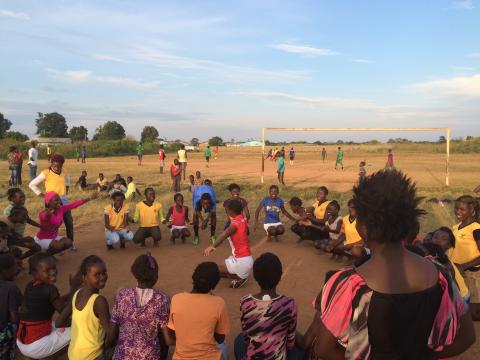You are in this section
Staff Blog: The beautiful contrasts of project visits
Dawn Goodwin, Head of Programme Delivery, shares experiences from her recent field visit to Zambia, where International Inspiration (IN) supports programmes that use sport to teach young people about gender equity, empowerment and education.
Life is full of contrasts and this visit has been no exception. From the hustle and bustle of negotiating rush hour traffic in Lusaka, to the quiet crackle of land being cleared by fire on a footpath in a rural community. From meeting partners and donors in air-conditioned offices to sitting under the shade of a tree with parents and leaders from a local village. From talking about strategies and reviewing budgets, to joining in warm up activities and debating the merits of Rooney and Ronaldo with a group of enthusiastic young men in a field in Mumbwa. Contrasts are very much a feature of our work in sport for development, but on this visit the most marked contrast for me has been between the impact that programmes have in reality and the systems we use to capture and report those impacts.
For the first few days of this visit I was helping a local partner to review the tools we use to track the progress of a great project that uses sport to empower girls and young women. In practice this involved long hours of meetings where we looked at revising surveys and questionnaires, reviewed indicators and targets, and compiled many, many different spreadsheets – getting dizzy looking at formulas in excel! Then, a 9 hour bus ride later, we were in Mufulira in the north of Zambia meeting with young women who had been trained as peer leaders and now regularly coach teams of girls in netball, football or volleyball. As part of their coaching programme they provide a safe space for the girls to talk through the issues they face and access information that’s crucial to their wellbeing, helping them to make informed decisions about their future. Talking to these girls the confidence they had, the stories they told and the sense of community they created brought home to me once again what an incredible and unique space sport can create.
Later in the week I had the privilege to travel west of Lusaka to Mumbwa, visiting a programme where football is being used as a tool to talk with boys and young men about gender based violence, helping to address negative attitudes towards women and create a safer environment. Listening to the young men talk openly about incredibly sensitive issues, exploring what it means to be a “real man” and talking about what kind of men and fathers they want to be, I was again blown away by the way in which sport can be used to really connect with children and young people in such a profound and meaningful way. In both cases I was left with absolutely no doubt that sport can be an effective and valuable tool in helping to build a more inclusive world of unity, equity and opportunity for all.
But in listening to those young men and women, the contrast between the meaningful changes in real lives and the spreadsheets and indicators in which we try and capture that impact seemed so far apart. This begs a familiar question: how do we explain the impact that sport for development can have? Indicators and numbers are absolutely invaluable in capturing the scale and scope of the impact, and case studies certainly help highlight individual examples – but nothing I’ve come across to date adequately captures the depth of impact that I’ve seen when visiting projects. And that’s a real shame. Even as I’m writing now, I struggle to put into words just what that impact is – but there has to be a way, and that’s a very exciting challenge for IN. To quote William Blake “without contraries there is no progression,” and in that tension between the lived experiences of sport for development programmes and the tools we use to explain them, I think we find very pressing call to dig deeper, to think creatively and find new ways of sharing what sport for development can really do.

